|
|
| home > files |
| Sergio
Mannino. A path between sensoriality and fragments Elisabetta Trincherini |
||||
| [in italiano] | It
seems to me that two different spirits coexist in and permeate Sergio
Mannino's work. On the one hand he attaches significance to sensory
dynamics; on the other hand he interprets post-modernity, the area in
which he operates, as a reality characterized by a multitude of "fragments
once far apart and now, in essence, quite close." Both these
spirits, however, derive from the same matrix, understood as the desire
to interpret and closely connect contemporaneity to the human dimension.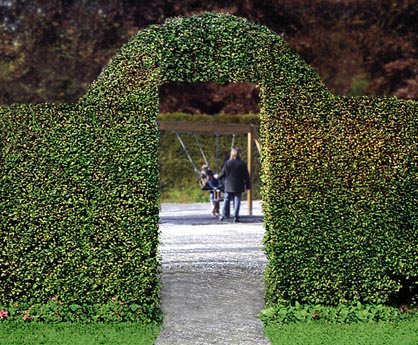 One of the "Open rooms" from the project "Area Lunghe-notti", with Lucia Gori, Firenze, 2000. At the heart of his design universe, whether he is dealing with buildings or objects, the sensory component clearly reveals the influence of Sottsass. Indeed the Austrian architect drew upon this value as a foundation for contemporary design when, in '81, his Memphis group specifically addressed "emotional value, uniquely capable of creating a point of reference within new trends."(1) |
[24mar2005] | ||
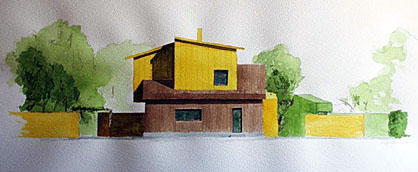 Thesis "1+1+1+1+1", House n. 2, Front elevation, Warsaw, 1999.  Thesis "1+1+1+1+1", Warsaw, 1999. Sottsass was Mannino's thesis advisor in '99 (2), when the latter designed a series of single-family dwellings in Warsaw, where basic criteria are sought in the experience of the future owners and in the relationship between interior and exterior spaces, and where both aspects are equally valued and intense. Mannino, influenced by an earlier work by Grawunder (3), thought up an actual database with dozens of plants, selected on the basis of their resistance to the harsh Polish climate, ease of upkeep, adaptability to a small plot of land, and, not least, esthetic beauty. The entire database is organized according to height, diameter, and flowering period, so the user can overcome the serial nature of the spaces with strongly personalized accents. |
 Thesis "1+1+1+1+1", House n. 2, First floor plan, Warsaw, 1999. |
|||
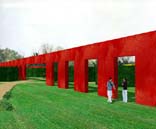 "Area Lunghe-notti", with Lucia Gori, Firenze, 2000. |
 "Area Lunghe-notti", The "Open rooms", with Lucia Gori, Firenze, 2000. Mannino continued his training, working as Remo Buti's assistant for an interior design course at the University of Florence. During this period he participated in many architecture and design competitions and in 2000 won, with Lucia Gori, the competition to redesign the former Longinotti area (4) in Florence with a design that renames the area Lunghe-Notti (Long-Nights). Simultaneously balanced and surprising, the project, which delineates a series of "open rooms" created with hedges, calls for certain spaces to have specific functions and leaves others indeterminate, translating into practice the idea of creating architecture around people, with some places mirroring concrete needs and others, instead, open to free interpretation.  Designing the High Line, "The black room", New York, 2003, with Lucia Gori. The same themes came into play in the High Line competition (5) in New York, designed once again with Lucia Gori. Here the idea is to take this long, narrow street, isolated from the city, and to reinvent it as an architectural experiment, dividing it into 50 segments, each with its own identity, to be "worn," like an article of clothing, depending on the harmony that exists at a given moment between an individual and a place. Thus a place, in the broadest sense of the term, is tantamount to a response to the alarm bells set off by much contemporary anthropology – as in the work of Augé, for example, who theorized the dangerousness of "non-places" that often result from contemporary design and to which no value can be ascribed other than the power of the financial backers and the efficiency of architects and engineers. |
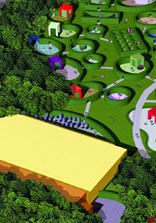 "Area Lunghe-notti", with Lucia Gori, Firenze, 2000. |
||
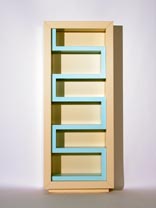 Piece of furniture n. 34, "Cento storie", 2002.  "Tetris", Piece of furniture n. 27, "Cento storie", 2002. 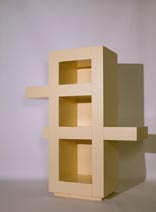 "Space Invaders", Piece of furniture n. 66, "Cento storie", 2002. |
 Piece of furniture n. 3 "Cento storie", 2002. For his 2002 solo exhibition at the Galleria Post Design in Milan, Sergio Mannino thoroughly addressed certain themes that placed him in an international context. The show, entitled Cento Storie (One Hundred Stories) (6), included 9 pieces of furniture and 100 watercolors. The furniture was meant to represent the identity of the post-modern object, created through heterogeneous juxtapositions of materials and audacious associations of colors and forms, while the watercolors were meant to reveal a specific vision of the world, in order to make imaginary spaces feasible. Approaching these objects, it is easy to detect tributes to illustrious sources: dissonant materials, translated from the work of Sottsass; a neo-Pop component that characterizes the school of Buti; the use of lights, which pervade objects, a refined reference to a little-known furniture series bearing the signature of Giò Ponti. In these objects, one can intuit a proliferation of fantasy, joined to complexity, created by a play of viewpoints that provokes the participation of the user-spectator, who can come upon the object, freed from schemes, ex-novo. |
 "Red light bed-side table", Piece of furniture n.20, "Cento Storie", 2002. 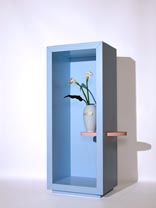 "A flower for you", Piece of furniture n. 2, "Cento storie", 2002 (Ceramic vase by Remo Buti). |
||
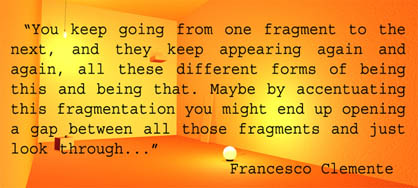 "My own room", Competition "Open living in container", Tokyo 2004. The underlying themes tied to the senses thus are enriched with a broader panorama that invests the idea of the fragmentary. And for Mannino, the fragmentary connotes the dimension of globalization, not to be understood, according to him, as a flattening of reality, but as the coexistence, in the same time and space, of infinite aspects, viewpoints, and fragments of the contemporary world. It seems possible to think of this as an infinitely broken down reality, where the study of the individual "piece" can facilitate the comprehension of the whole. Here one can easily locate a reference to "fractals," geometric figures characterized by the infinite repetition of a single motif on an increasingly reduced scale. Similarly Mannino thinks that the globalization of information does not move toward a homogeneous culture, but instead, looking at the ever-smaller view, produces the coexistence of billions of "shards," similar but different. |
||||
 Dream #1 "The dream of the lost links", Vase from the series "Dreams", prototype, March 2004.  Dream#14 "Forgotten dream", Vase from the series "Dreams", prototype, March 2004. |
 Piece of furniture n. 39, detail, "Cento Storie", 2002. The references that have led Mannino to these reflections are diverse and disparate, ranging from Araki to Calvino, by way of Godard and Benjamin, and it would seem that in all of them, despite their different concerns and specificities, the logic of the fragment stands out as the determining element. Thus there is also a profound philosophical substratum, not immediately perceptible, that would seem to reveal that it is certain of Benjamin's theories that are most congruent with the architect's conclusions. The German philosopher investigates the dimension of objective reality and frames "things-commodities" as influencing man's behavior, without man being aware of it; however when the ugliness of the object "frightens," then mankind is forced to awaken. As a result, the source of "dialectic salvation" ends up being extraneous to the process of production. In this context, objects whose functionality is pushed to the limit of non-being take on importance, or rather a functionality is present that warps the habitual one, or again a functionality emerges that celebrates the "accidental." For Benjamin, one need not try to understand these objects through a rational attitude, but rather through an attitude of "estranged" contemplation. (7) |
 Dream#8 "It's fading out of my dreams", Vase from the series "Dreams", prototype, March 2004.  Dreams. March 2004. |
||
 Piece of furniture n. 100, "Cento storie", 2002. |
The
art-technology relationship should not be sought in an idea of generally
understood beauty, but in an unbiased creative frenzy. A long encounter-confrontation
with Vanessa Beecroft resulted in the artist and architect coming up
with a different way of approaching the design process. For Mannino,
research is never geometric-mathematical, but always related to the
senses, and when materials or colors or proportions are chosen, the
architect wonders about the consequences of this choice on the user
of the object. Conversely, Beecroft creates her performances beginning
from a mathematical-abstract concept, thinking about points in space
that are then concretized by the young women she uses. For her too,
however, the sensory element enters into play in decisive fashion, and
she looks for it in the public's reaction to the performances she has
staged. For several years Mannino has lived and worked in New York,
where he has been confronted continuously with his "fragmentary"
concept of the globalized world, perceptible through a post-modern identity
that is at this point trans-territorial and multilinguistic. This is
the same New York that, in '78, Rem Koolhaas depicted, in Delirious
New York, as a metropolitan universe made up of an infinite collage
of fragments. Elisabetta Trincherini super_beba@libero.it |
|||
| NOTES: 1. A. Branzi, La casa calda, Idea Books, Milan, 1984, p. 142. 2. S. Mannino, 1+1+1+1+1, Thesis in Interior and Architectural Design, Florence, 1999. 3. J. Grawunder, "Office living selection guide," in Fase Alternativa, n. 2, appendix to supplement n. 479 of "Interni", April, 1998, p. 74. 4. E. Cardani, Architettura come luogo, in "l'Arca", n. 162, p. 90. 5. http://www.newitalianblood.com/testi/testo252.html 6. G. Pettena, 100 Storie, in "l'Arca", n. 174, p. 90. 7. W. Benjamin, Parigi capitale del XIX secolo, Turin, Einaudi, 2000. W. Benjamin, Angelus Novus, saggi e frammenti, Turin, 1981. |
||||
| Translated from Italian by Marguerite Shore. Pictures of the vases from the series "Dreams" are by Gloria Pichhadze and Anna Genova. | ||||
| Elisabetta Trincherini is a Teaching Assistant at the department of History of Architecture in Florence, Italy. She had graduated with a degree in Art History with her thesis entitled "A critic on fetichism in contemporary art: from Duchamp to Pistoletto". She is now pursuing her second degree in Communication Theories. She has written for Architectural catalogues and Philosophy magazines. | ||||
| > SERGIO MANNINO | ||||